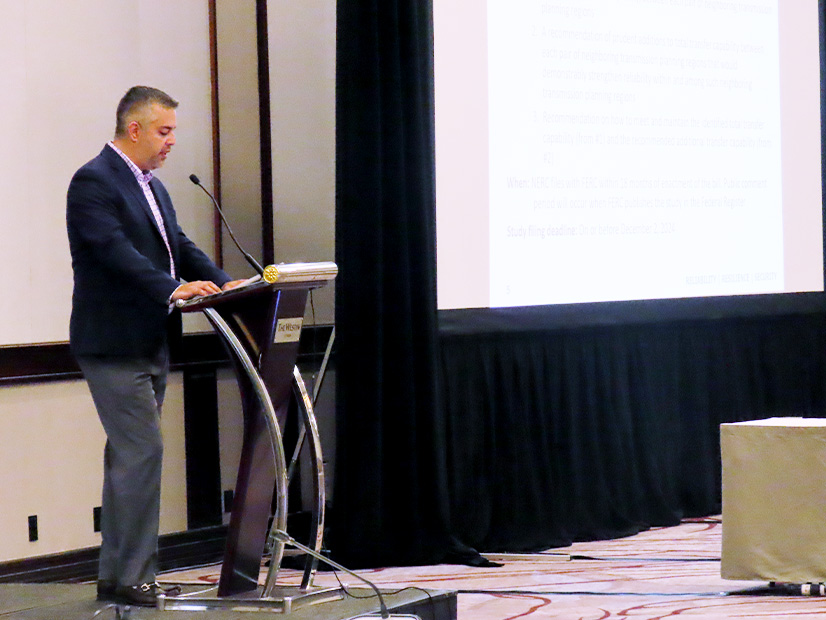
At NERC’s quarterly technical session last week in Ottawa, the ERO’s staff said they’re confident they can finish the congressionally mandated Interregional Transfer Capability Study (ITCS) despite the relatively tight time frame given by lawmakers.
NERC added the technical sessions to the schedule of events for its Board of Trustees and Member Representatives Committee meetings to host more in-depth discussions on topics of interest to the ERO. Last week’s session featured an extended discussion of the ITCS, which has caused considerable discussion among NERC and other stakeholders because of its effect on the ERO’s work plan and budget for 2023 and 2024. (See FERC Approves NERC Transfer Study Funding Request.)
Speakers at the technical session emphasized the importance of the study, which Congress mandated when it passed the Fiscal Responsibility Act in June and which must be submitted to FERC by December 2024. Mark Lauby, NERC’s senior vice president and chief engineer, called the work necessary preparation for the rapidly changing electric grid.
“It’s really a critical time to be looking at transfer capability, because as our system is now [evolving] to one that is much more energy-constrained and not capacity-driven, it’s very important for us to understand where the energy is and where it isn’t, and make sure we have an ability to get from where it is to areas that are [in] deficit,” Lauby said.
John Moura, NERC’s director of reliability assessment and performance analysis, said that while “another study … might not answer every single question that we have,” the ERO sees the ITCS “as an essential component to the energy transformation story arc” that the grid is undergoing. Moura said he saw “no better set of organizations suited to do this” than NERC and the regional entities, which represent an “independent and objective voice.”
Study Comprises Three Tasks
Moura illustrated NERC staff’s approach to the study, and its three components mandated by Congress, with a simplified visualization presenting two systems: one with 200 MW of load and 120 MW of generation — representing a deficiency of 80 MW — and the other with 200 MW of load and 260 MW of generation, a 60-MW surplus.
Task 1, Moura explained, is to calculate the transfer capability between the two systems — in this theoretical case, one system can transfer 40 MW to the other over existing lines and the other can transfer 50 MW, which “isn’t sufficient in meeting what the [system] on the left’s load requirement is.” Therefore, the second task is to determine where deficiencies exist, and how much additional transfer capability would resolve the issues. Under the example presented, adding 30 MW of capability should address the deficiency.
The third task, which Moura called the most important, is to “evaluate what is needed to meet and maintain these transfer limits.” This means, for example, addressing the ability of the system on the right to deliver the 80 MW needed by the system on the left, when it only has a surplus of 60 MW.
“Generation is just as important to transfer capability as transmission,” Moura said. “It’s not all about stringing the wires; we’re going to need generation to support the transfer capability, so we’ll need to identify those needs as well.”
Industry Help Needed
While Congress’ mandate puts NERC “at the helm,” Moura said engagement across industry also will be required. So, the ERO will form the ITCS Advisory Group “in the coming weeks” to provide advice and input on the study scope, approach, results and recommendations. Moura called this group “the tip of the spear for stakeholder coordination,” and said it will review the final report and the recommendations, though the ERO Executive Leadership Group will be in overall control of the study.
Until recently the project was in what NERC staff called “Phase 0” — focused on defining the scope and assumptions, stakeholder engagement and preparing data requests — while awaiting FERC’s approval for its payment strategy, which required redirecting funds budgeted for 2023 and drawing from NERC’s financial reserves. The commission gave its assent on Aug. 10, and the study entered Phase 1, which consists of identifying generation deficient and surplus areas, performing transfer capability analysis and identifying thermal, voltage and stability limits.
NERC expects to prepare a draft of the final report by August 2024, with comments to be solicited from stakeholders over the following three months. While the final report will be submitted at the end of the year, the ERO expects to remain active providing support to FERC as it reviews the study, and in conducting further research and support as needed.
“This is not just to submit to FERC and do nothing. We’d like this to really mean something and for it to be a launchpad for policy and other developments that will occur,” Moura said. “There are benefits beyond the ITCS — substantial benefits — in gaining the expertise and capability to perform these studies.”



